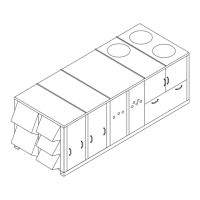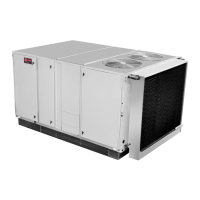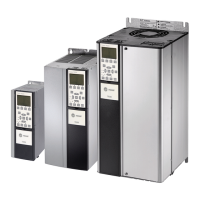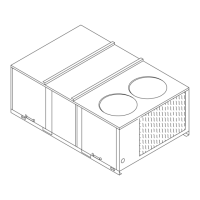RT-SVX34R-EN
119
Cooling Season
WWAARRNNIINNGG
HHaazzaarrddoouuss VVoollttaaggee!!
FFaaiilluurree ttoo ddiissccoonnnneecctt ppoowweerr bbeeffoorree sseerrvviicciinngg ccoouulldd
rreessuulltt iinn ddeeaatthh oorr sseerriioouuss iinnjjuurryy..
DDiissccoonnnneecctt aallll eelleeccttrriicc ppoowweerr,, iinncclluuddiinngg rreemmoottee
ddiissccoonnnneeccttss bbeeffoorree sseerrvviicciinngg.. FFoollllooww pprrooppeerr
lloocckkoouutt//ttaaggoouutt pprroocceedduurreess ttoo eennssuurree tthhee ppoowweerr
ccaann nnoott bbee iinnaaddvveerrtteennttllyy eenneerrggiizzeedd.. VVeerriiffyy tthhaatt nnoo
ppoowweerr iiss pprreesseenntt wwiitthh aa vvoollttmmeetteerr..
☐ Check the unit’s drain pans and condensate piping
to ensure that there are no blockages.
☐ Inspect the evaporator and condenser coils for dirt,
bent fins, etc. If the coils appear dirty, clean them
according to the instructions described in “Coil
Cleaning” later in this section.
☐ Inspect the F/A-R/A damper hinges and pins to
ensure that all moving parts are securely mounted.
Keep the blades clean as necessary.
WWAARRNNIINNGG
RRoottaattiinngg CCoommppoonneennttss!!
FFaaiilluurree ttoo ddiissccoonnnneecctt ppoowweerr bbeeffoorree sseerrvviicciinngg
ccoouulldd rreessuulltt iinn rroottaattiinngg ccoommppoonneennttss ccuuttttiinngg
aanndd ssllaasshhiinngg tteecchhnniicciiaann wwhhiicchh ccoouulldd rreessuulltt iinn
ddeeaatthh oorr sseerriioouuss iinnjjuurryy..
DDuurriinngg iinnssttaallllaattiioonn,, tteessttiinngg,, sseerrvviicciinngg aanndd
ttrroouubblleesshhoooottiinngg ooff tthhiiss pprroodduucctt iitt mmaayy bbee
nneecceessssaarryy ttoo wwoorrkk wwiitthh lliivvee aanndd eexxppoosseedd
rroottaattiinngg ccoommppoonneennttss.. HHaavvee aa qquuaalliiffiieedd oorr
lliicceennsseedd sseerrvviiccee iinnddiivviidduuaall wwhhoo hhaass bbeeeenn
pprrooppeerrllyy ttrraaiinneedd iinn hhaannddlliinngg eexxppoosseedd rroottaattiinngg
ccoommppoonneennttss,, ppeerrffoorrmm tthheessee ttaasskkss..
☐ Manually rotate the condenser fans to ensure free
movement and check motor bearings for wear.
Verify that all of the fan mounting hardware is tight.
☐ Verify that all damper linkages move freely;
lubricate with white grease, if necessary.
☐ Check supply fan motor bearings; repair or replace
the motor as necessary.
☐ Check the fan shaft bearings for wear. Replace the
bearings as necessary.
NNoottee:: These bearings are considered permanently
lubricated for normal operation. For severe
dirty applications, if relubrication becomes
necessary, use a lithium based grease. See
Table 69, p. 120 for recommended greases.
IImmppoorrttaanntt:: The bearings are manufactured using a
special synthetic lithium-based grease
designed for long life and minimum
relube intervals. Over lubrication can be
just as harmful as not enough.
☐ Use a hand grease gun to lubricate these bearings;
add grease until a light bead appears all around the
seal. Do not over lubricate! After greasing the
bearings, check the setscrews to ensure that the
shaft is held securely. Make sure that all bearing
braces are tight.
☐ Check the supply fan belt(s). If the belts are frayed
or worn, replace them. Refer to the “Fan Belt
Adjustment,” p. 116 for belt replacement and
adjustments.
☐ Check the condition of the gasket around the
control panel doors. These gaskets must fit
correctly and be in good condition to prevent water
leakage.
☐ Verify that all wire terminal connections are tight.
☐ Remove any corrosion present on the exterior
surfaces of the unit and repaint these areas.
☐ Generally inspect the unit for unusual conditions (e.
g., loose access panels, leaking piping connections,
etc.)
☐ Make sure that all retaining screws are reinstalled in
the unit access panels once these checks are
complete.
☐ With the unit running, check and record the
following:
– ambient temperature
– compressor oil level (each circuit)
– compressor suction and discharge pressures
(each circuit)
– superheat and subcooling (each circuit)
Record this data on an “operator’s maintenance log”
like the one shown in , p. 121. If the operating
pressures indicate a refrigerant shortage, measure the
system superheat and system subcooling. For
guidelines, refer to “Charging by Subcooling,” p. 105.
IImmppoorrttaanntt:: Do not release refrigerant to the
atmosphere! If adding or removing
refrigerant is required, the service
technician must comply with all federal,
state and local laws. Refer to general
service bulletin MSCU-SB-1 (latest edition).
Heating Season
WWAARRNNIINNGG
HHaazzaarrddoouuss VVoollttaaggee!!
FFaaiilluurree ttoo ddiissccoonnnneecctt ppoowweerr bbeeffoorree sseerrvviicciinngg ccoouulldd
rreessuulltt iinn ddeeaatthh oorr sseerriioouuss iinnjjuurryy..
DDiissccoonnnneecctt aallll eelleeccttrriicc ppoowweerr,, iinncclluuddiinngg rreemmoottee
ddiissccoonnnneeccttss bbeeffoorree sseerrvviicciinngg.. FFoollllooww pprrooppeerr
lloocckkoouutt//ttaaggoouutt pprroocceedduurreess ttoo eennssuurree tthhee ppoowweerr
ccaann nnoott bbee iinnaaddvveerrtteennttllyy eenneerrggiizzeedd.. VVeerriiffyy tthhaatt nnoo
ppoowweerr iiss pprreesseenntt wwiitthh aa vvoollttmmeetteerr..
MMaaiinntteennaannccee

